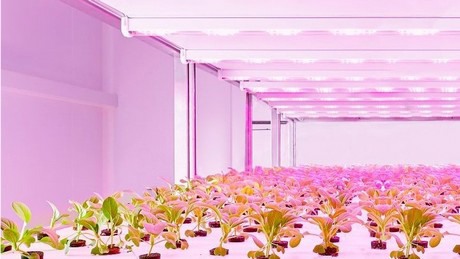As LED lighting has become more and more popular among growers, LED lighting technology has been rapidly evolving to meet their needs. Luminaires have become more powerful, efficient and versatile. Now they are getting even smarter! At Signify’s GrowWise research facility, we have been experimenting with a color controllable luminaire, which provides a whole new level of lighting flexibility for indoor farming facilities. The GreenPower LED production module 3.0 allows you to control both the color spectra and light levels to create so-called dynamic light recipes. At GrowWise, we have been carrying out extensive research with these dynamic light recipes and would like to share 4 remarkable results we have seen.
by Angela van der Heide, Thijs van den Bergh and Céline Nicole
Remarkable result 1: Turning greens into reds right before harvest
Our red coloration recipe is perhaps the most powerful demonstration of how a dynamic light recipe can improve the business case of a grower. We have tested many pre-harvest treatments on leafy greens by changing the light spectrum and/or light level just days before harvest. Green leaves are typically very efficient at photosynthesis, while red leaves of, for example, a red coloring lettuce, opal basil, red bok choy or mizuna are much less efficient. Outdoors, we have no control over whether these crops grow green or red leaves. But indoors, we can use our dynamic light recipe to first establish a strong canopy of leaves that are green and efficient and then use our red coloration recipe to trigger the development of red pigments right before harvest. This helps growers get higher yields of healthier, more vibrantly colored red crops.1
Remarkable result 2: Reducing nitrate concentrations in leafy greens
In spinach and lettuce, we find that by applying a specific light recipe just days before harvest we can reduce nitrate concentrations. Outdoors or in a greenhouse it is difficult to control the amount of nitrates during certain times of the year. Using a dynamic light recipe at the end of the growth phase allows us to reduce nitrate concentration, thus giving growers control over these nitrate levels. This is especially valuable for several countries where growers face very strict nitrate limits, which are especially hard to meet during certain parts of the year. Here, the proper light recipe can make the difference between a rejected crop and a sellable crop.
Remarkable result 3: Boosting vitamin C in arugula
We nearly doubled the vitamin C content in arugula using a specific pre-harvest treatment to increase vitamin C concentrations in leaves. Values obtained are an order of magnitude more than the value published by USDA for Arugula and bring the vitamin C content of this leafy green in the value range of those most concentrated fruits in vitamins such as kiwi! This proves that it is possible to improve the content of functional ingredients in food in a natural way by simply growing it differently. This allows growers to use dynamic light recipes to meet the growing demand for functional foods from health-conscious consumers.
Remarkable result 4: Extending shelf life
Another important benefit of dynamic light recipes is extending the shelf life of crops. We have certain (pre-) harvest treatments which can increase the shelf life of a crop up to 6 days depending on the crops. This can give a grower a huge advantage in their market, leading to less waste further on in the food chain.

Other advantages of dynamic light recipes
The secret to these remarkable results lies in the flexibility that dynamic light recipes give to growers. They can adapt the color of the spectra and light intensity to steer specific plant characteristics, such as taste, color, texture and nutrient content, without having to change their lighting installation. Color controllable lighting also offers clear business benefits. A color controllable lighting installation makes a vertical farm more flexible to grow different crops at different points in time, compared to dedicated lighting modules with fixed lighting parameters. They also simplify installation and logistics and thereby reduce labor costs, because one color controllable module can do the work of several dedicated modules. Growers can save on energy costs by adjusting the light level to each growth phase. Dynamic light recipes can also give growers an additional competitive advantage, by allowing them to fine-tune the growth and morphology of a crop to optimize quality and yield.
Where do we go from here?
This is just the start and we expect to see an explosion of new developments with dynamic light recipes. How can we use them to further steer the nutritional compounds of a crop? How can different sunrise and sundown scenarios benefit crops? The number of options in providing different wavelengths across the day are virtually endless. We are currently in the process of exploring use cases for such dynamic lighting options. But this is just a small part of the research going on. We know that dynamic lighting gives growers endless opportunities to explore new pathways and we expect to see many new remarkable findings in the future. So, keep checking our Hortiblogs for the latest results.
1 Nicole, C.C.S., Charalambous, F., Martinakos, S., van de Voort, S., Li, Z., Verhoog, M. and Krijn, M. (2016). Lettuce growth and quality optimization in a plant factory. Acta Hortic. 1134, 231-238 DOI: 10.17660/ActaHortic.2016.1134.31
For more information:
Philips
www.philips.com/horti
